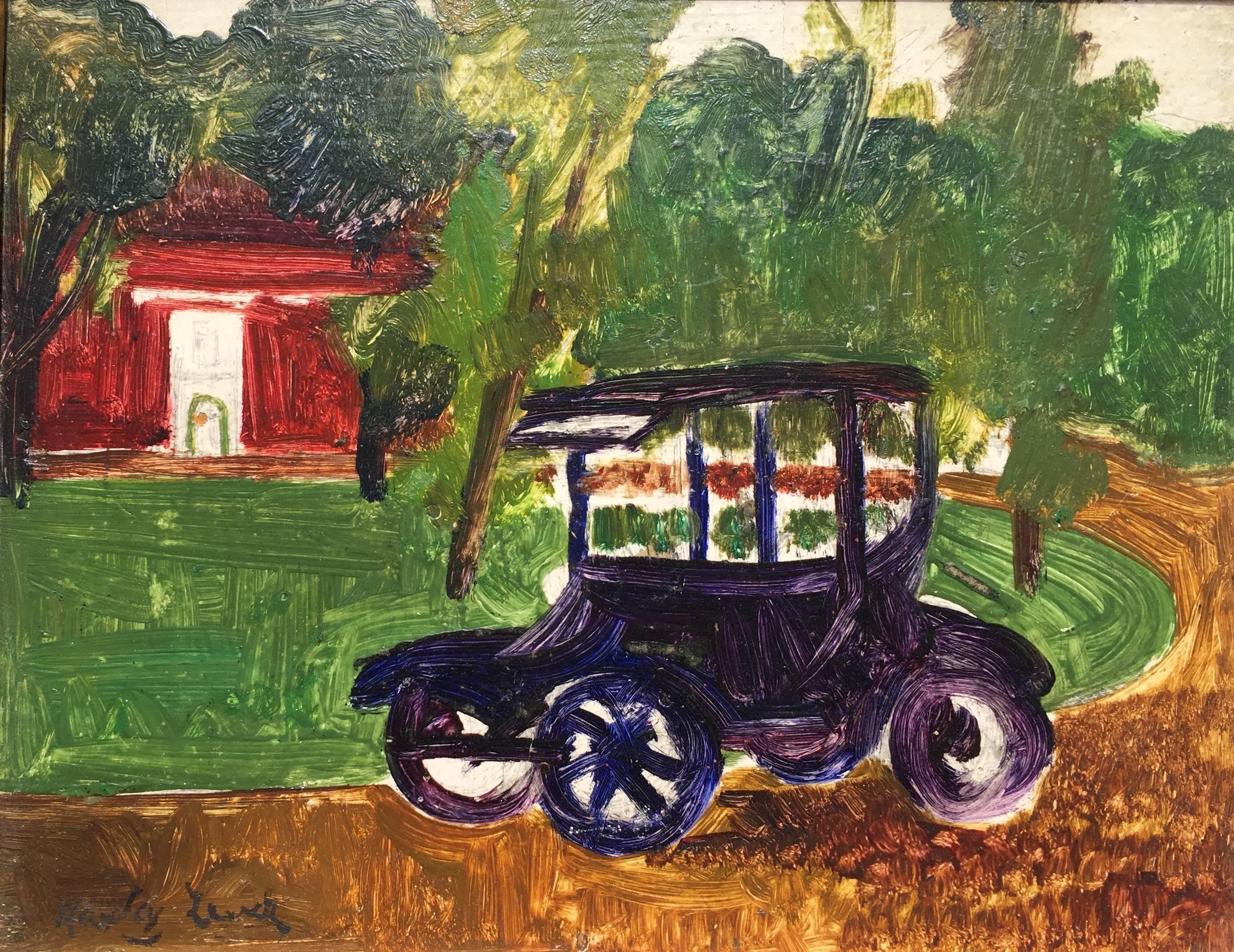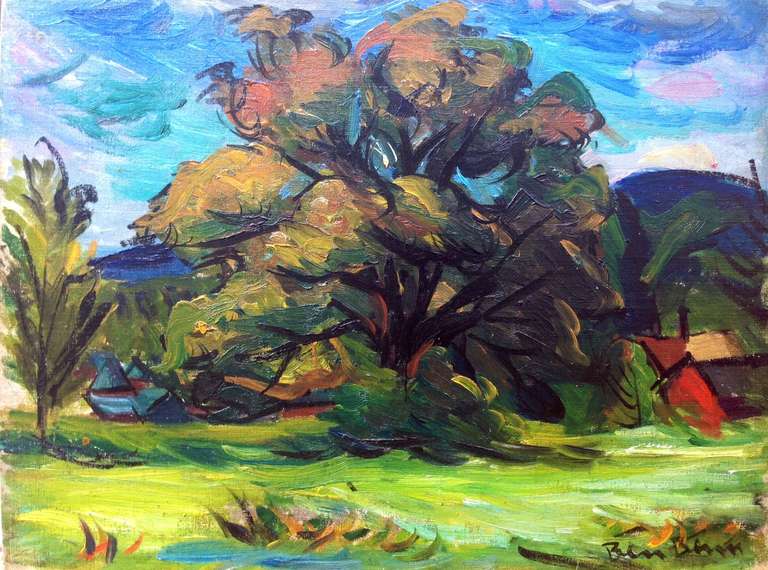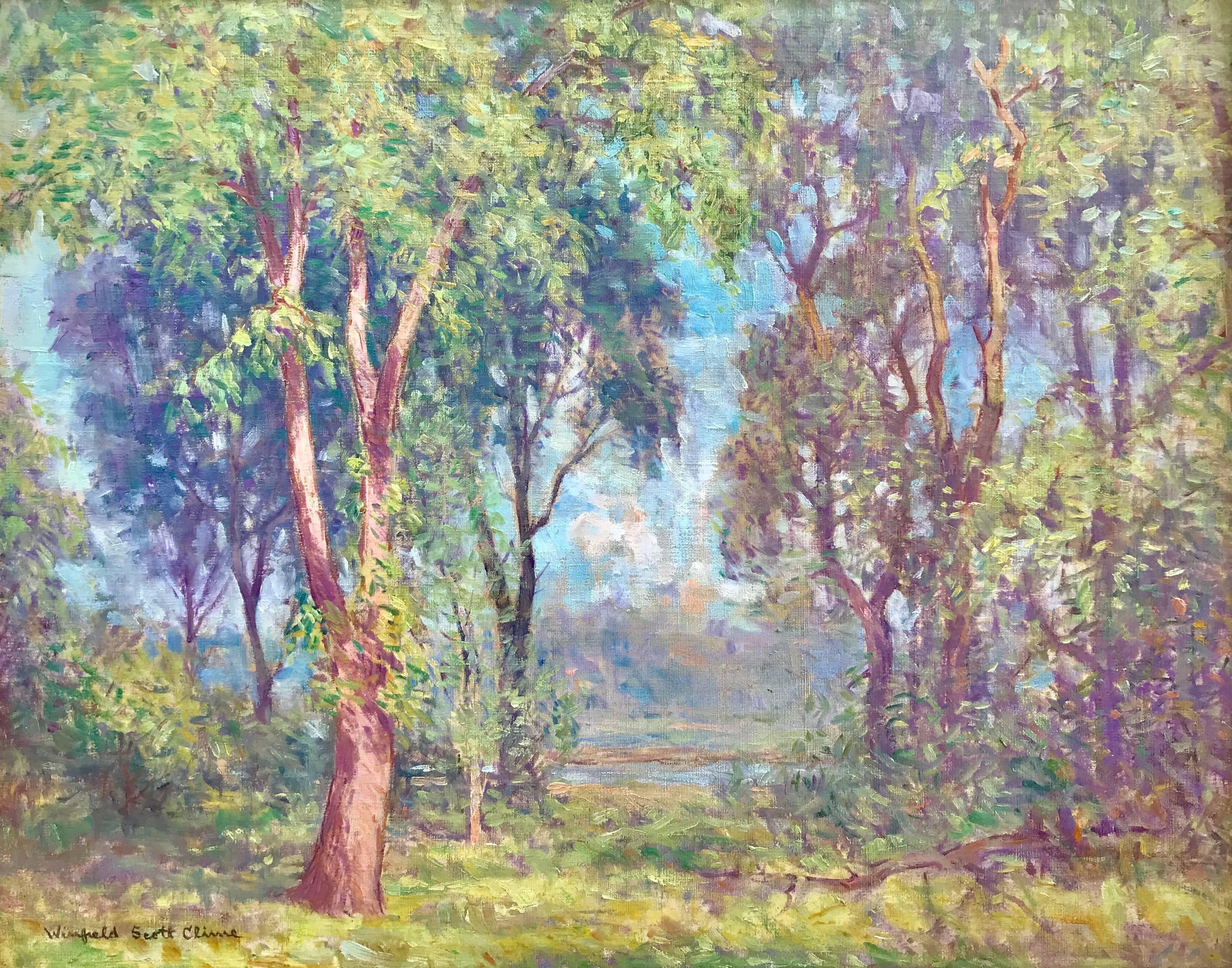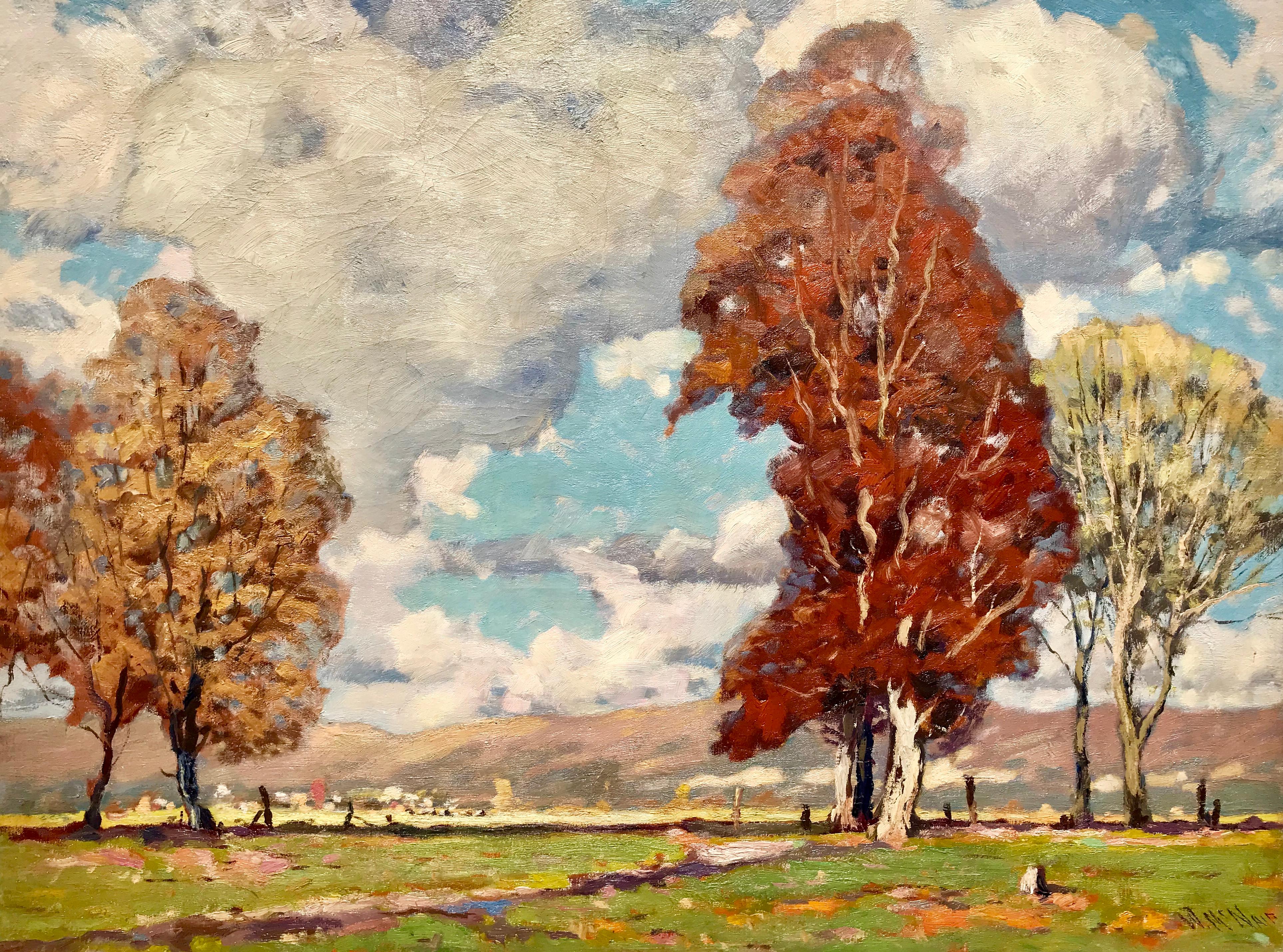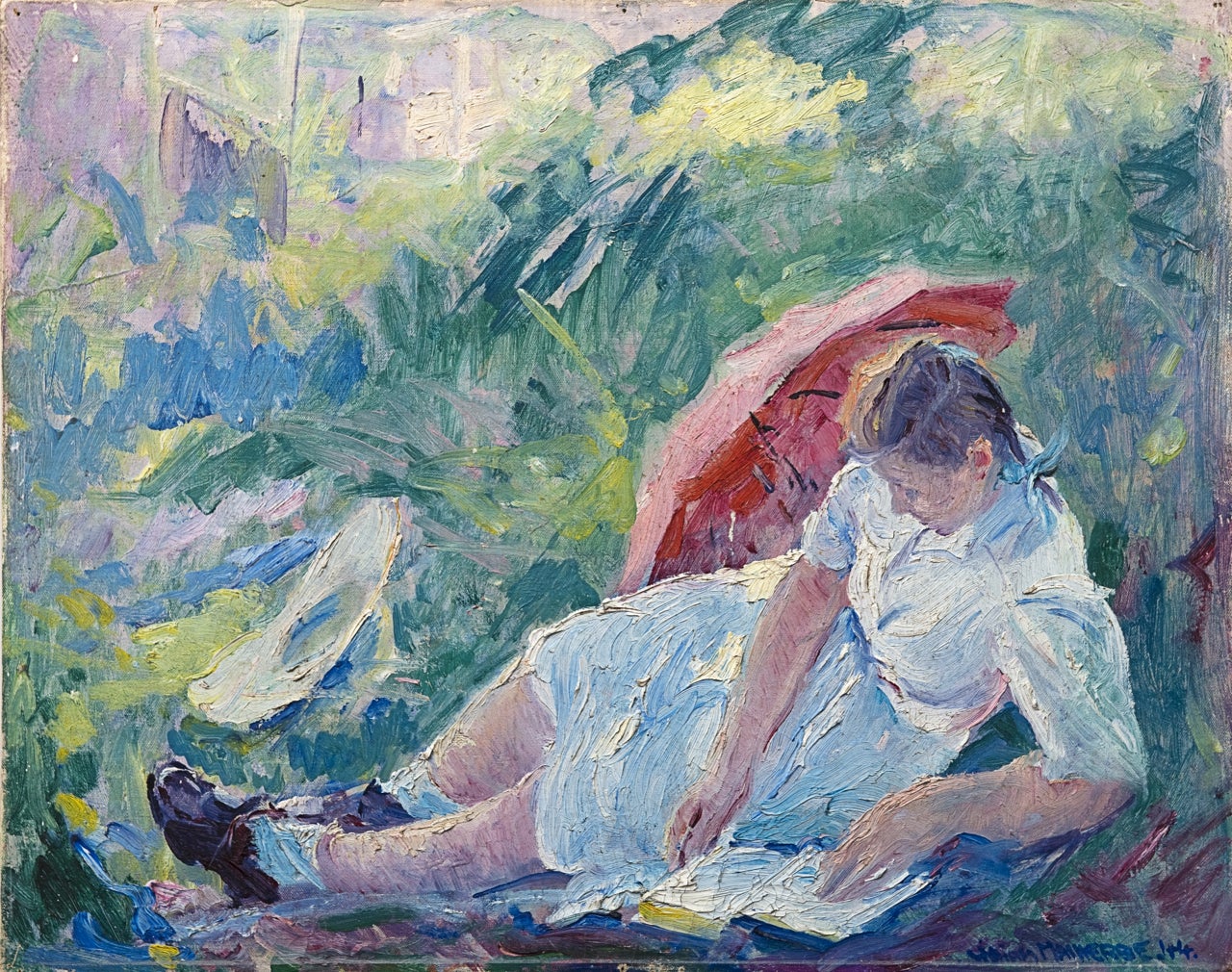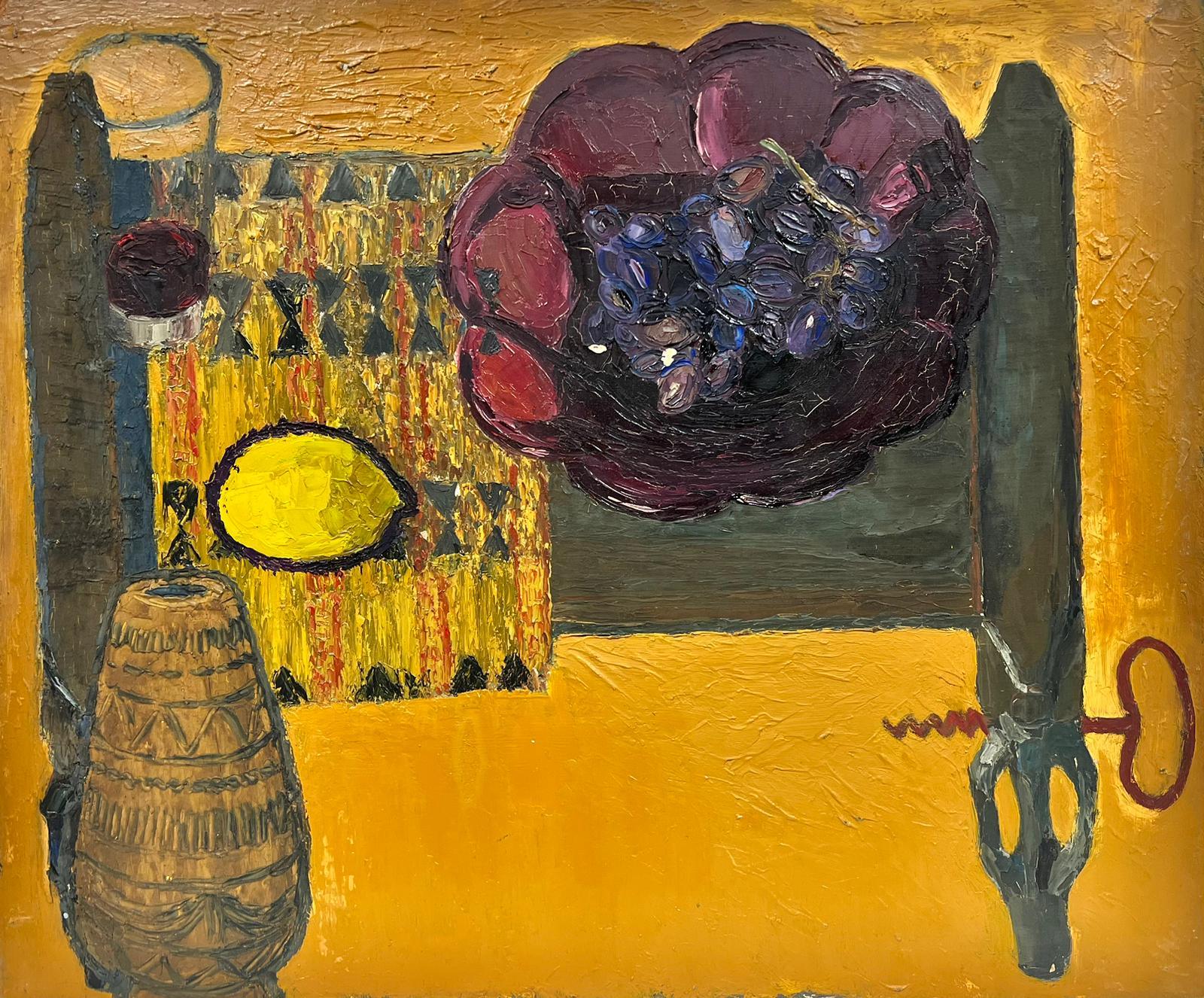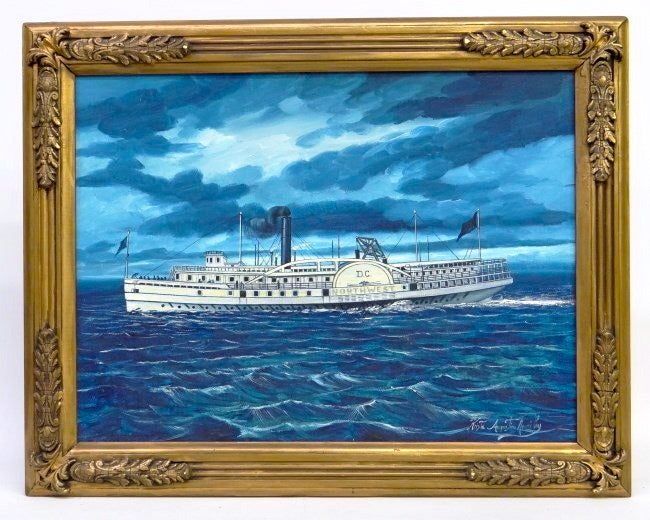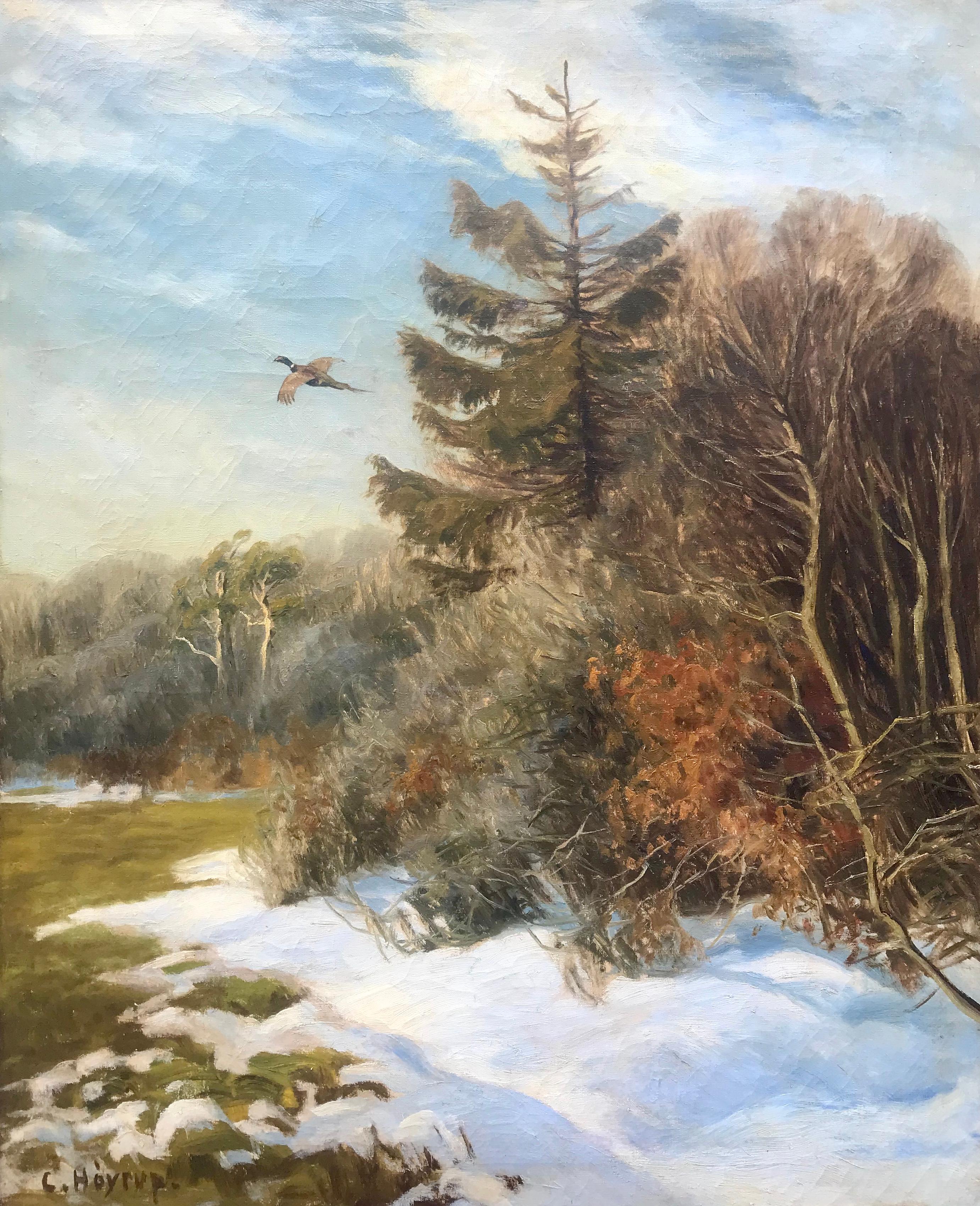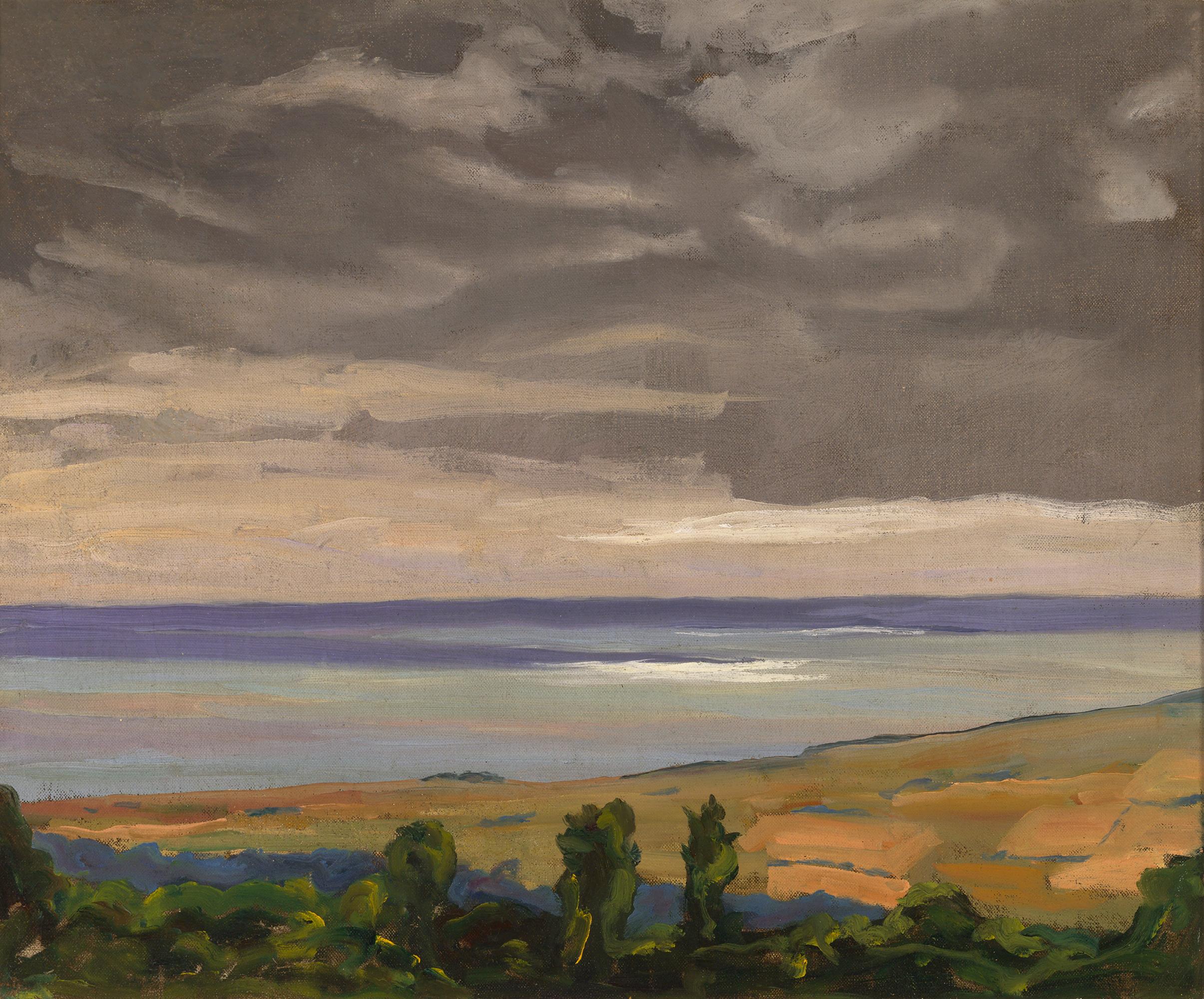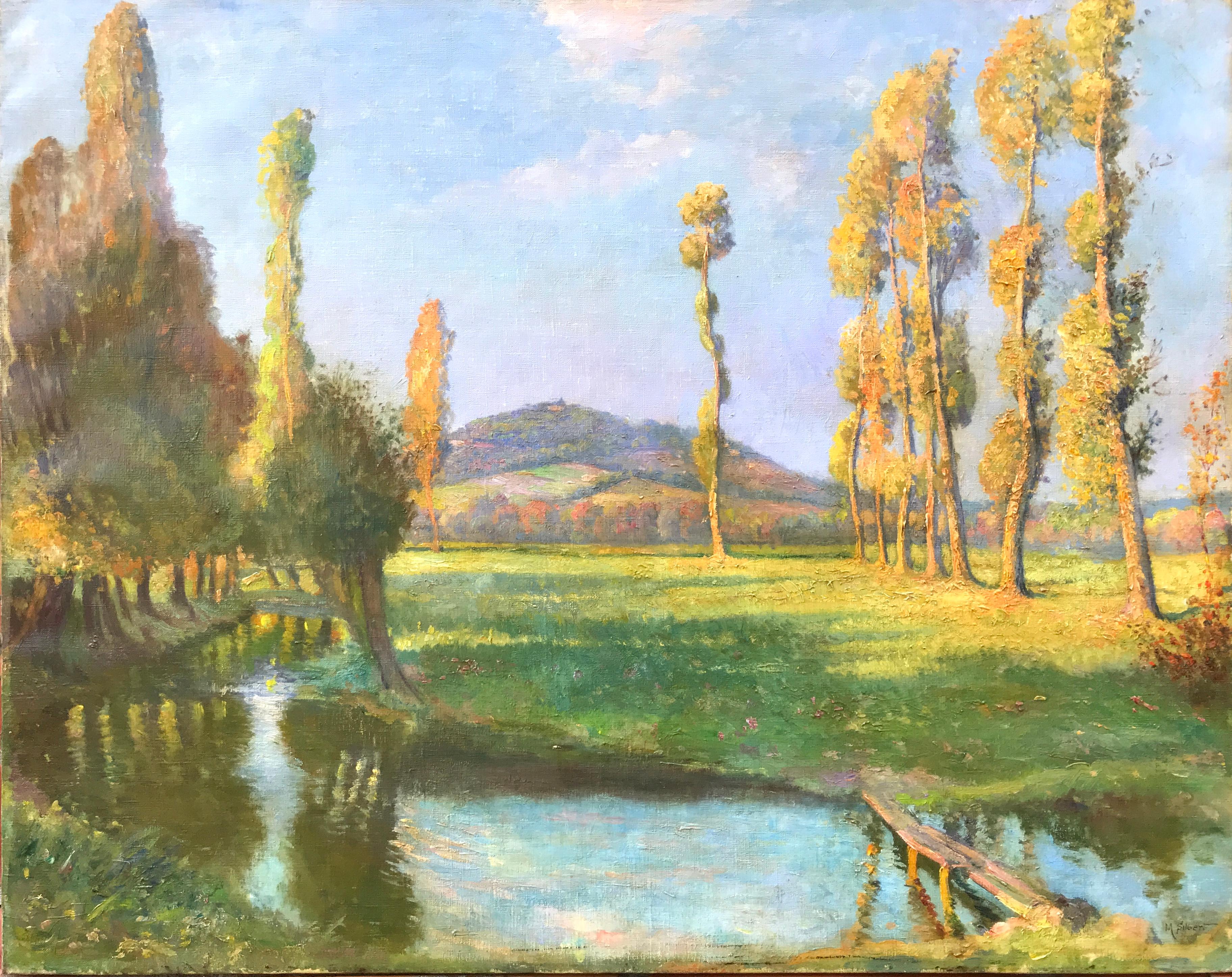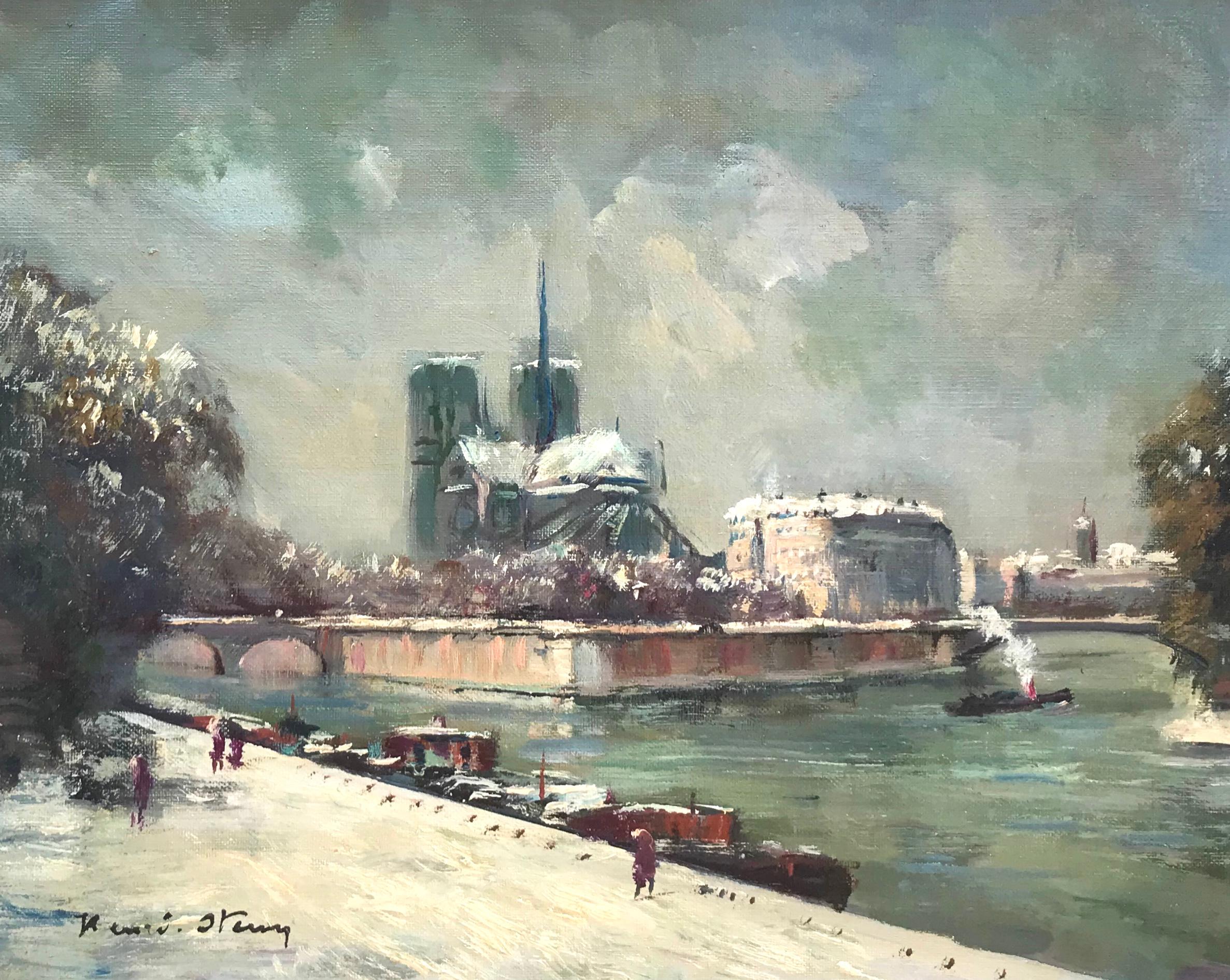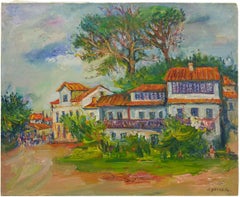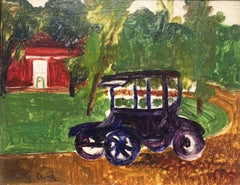
French Modernist Vivid Fauvist Landscape Oil Painting
View Similar Items
Want more images or videos?
Request additional images or videos from the seller
1 of 12
Claude HemeretFrench Modernist Vivid Fauvist Landscape Oil Painting
About the Item
- Creator:Claude Hemeret (1929, French)
- Dimensions:Height: 23.5 in (59.69 cm)Width: 29 in (73.66 cm)
- Medium:
- Movement & Style:
- Period:
- Condition:some minor paint loss in spots, craquelure, loss around edges from previous framing. (should be covered by frame) please see photos.
- Gallery Location:Surfside, FL
- Reference Number:1stDibs: LU3822497423
About the Seller
4.9
Platinum Seller
These expertly vetted sellers are 1stDibs' most experienced sellers and are rated highest by our customers.
Established in 1995
1stDibs seller since 2014
1,546 sales on 1stDibs
Typical response time: 1 hour
More From This SellerView All
- Modernist Oil Painting Moody Fauvist Abstract Nude Figure Ralph Della VolpeLocated in Surfside, FLRALPH DELLA-VOLPE (1923-2017) Fine Art Painter, American Contemporary Oil on canvas Hand signed lower right Artist Signed, Abstract Oil on Canvas. Figure in the distance. Approx: 30" x 27 1/2" framed, 26 1/2" x 23 1/2" canvas. TRAINING: National Academy of Design The Art Students League, NYC Ralph Eugene Della-Volpe's semi-abstract paintings of often simplified, minimalist, beach scenes and anonymous portraits "convey profound awareness of mood and character", and his paintings are hardly as literal as they may first appear (Arts Magazine. "New York Exhibitions". 1965). His brightly-colored, light-infused, ornamental compositions bring together aspects of many modernist art movements including Fauvism, Impressionism, Symbolism, and abstraction. Della-Volpe first studied painting at the prestigious National Academy of Design before joining the Army during World War II. As a soldier, the artist saw action on Utah Beach, winning a Purple Heart, and his experiences undoubtedly affected his later artistic style. The Fauvist "coloristic exuberance" found in the works beginning in the mid 1960's, with their vibrant fuschias and yellows, seem to offset what could be an otherwise solemn tone to many of his works at the time. Upon his return from military service, Della-Volpe’s style evolved significantly. In the years following the second world war, his work was solemn, imbued with a quiet darkness. Over time, this darkness faded: by the 1950s, influenced by his time at the Art Students League, his oeuvre was overtaken by the tenants of Abstract Expressionism. Paintings from this period boast bold brushwork, energetic compositions, and strong color. Although the next decade saw Della-Volpe trade expressionist abstraction for figuration, his love of color continued to shine through his work.Della-Volpe took a teaching position as the first artist-in-residence at Bennett College in Millbrook, New York where he remained for 28 years, serving as chairman of the Art Department for most of that time. Obviously influenced by impressionism 's preoccupation with the treatment of light, Della-Volpe's own works have a "faultless tonal quality, with its sense of failing light—the areas of silvery gray deepening into rosy tans" (Arts Magazine. "In the Galleries". 1960). Della-Volpe has exhibited widely throughout his career and has lectured on art at colleges, universities, and galleries across the country. He was included in the show Abstraction: 1950-1970 at Taylor Graham, Greenwich CT. A survey of post-war abstract art movements including Abstract Expressionism, Color Field, Hard Edge, Minimalism and Op-Art. Adolph Gottlieb, André Cottavoz, Carl Robert Holty, Cleve Gray, Friedel Dzubas, Ilya Bolotowsky, James Hiroshi Suzuki, Norman Bluhm, Ralph Della-Volpe, Theodore Appleby...Category
20th Century Fauvist Abstract Paintings
MaterialsCanvas, Oil
- Farmhouse in Provence, Post Impressionist Oil on CanvasBy Jacques ZuckerLocated in Surfside, FLGenre: Post Impressionist Subject: Landscape Medium: Oil Surface: Canvas Country: France Dimensions: 20" x 24" Jacques Zucker was born in 1900 in Radom, Poland. He was a notably famous Jewish American artist mostly known for his expressionist figure paintings. In his young years he traveled to Palestine to study fine arts at the Bezalel Art...Category
Mid-20th Century Post-Impressionist Landscape Paintings
MaterialsCanvas, Oil
- Modernist Abstract Oil Painting Marine Seascape Sunset w Boat Ralph Della VolpeLocated in Surfside, FLRALPH DELLA-VOLPE (1923-2017) Fine Art Painter, American Contemporary Sunset Sail Oil on canvas Hand signed lower right and verso 22 x 20 inches Provenance: The Estate of the artist Ralph Della Volpe TRAINING: National Academy of Design The Art Students League, NYC Ralph Eugene Della-Volpe's semi-abstract paintings of often simplified, minimalist, beach scenes and anonymous portraits "convey profound awareness of mood and character", and his paintings are hardly as literal as they may first appear (Arts Magazine. "New York Exhibitions". 1965). His brightly-colored, light-infused, ornamental compositions bring together aspects of many modernist art movements including Fauvism, Impressionism, Symbolism, and abstraction. Della-Volpe first studied painting at the prestigious National Academy of Design before joining the Army during World War II. As a soldier, the artist saw action on Utah Beach, winning a Purple Heart, and his experiences undoubtedly affected his later artistic style. The Fauvist "coloristic exuberance" found in the works beginning in the mid 1960's, with their vibrant fuschias and yellows, seem to offset what could be an otherwise solemn tone to many of his works at the time. Upon his return from military service, Della-Volpe’s style evolved significantly. In the years following the second world war, his work was solemn, imbued with a quiet darkness. Over time, this darkness faded: by the 1950s, influenced by his time at the Art Students League, his oeuvre was overtaken by the tenants of Abstract Expressionism. Paintings from this period boast bold brushwork, energetic compositions, and strong color. Although the next decade saw Della-Volpe trade expressionist abstraction for figuration, his love of color continued to shine through his work.Della-Volpe took a teaching position as the first artist-in-residence at Bennett College in Millbrook, New York where he remained for 28 years, serving as chairman of the Art Department for most of that time. Obviously influenced by impressionism 's preoccupation with the treatment of light, Della-Volpe's own works have a "faultless tonal quality, with its sense of failing light—the areas of silvery gray deepening into rosy tans" (Arts Magazine. "In the Galleries". 1960). Della-Volpe has exhibited widely throughout his career and has lectured on art at colleges, universities, and galleries across the country. SOLO SHOWS: Hotchkiss Library, Sharon, Conn Millbrook Library, Millbrook,NY Gregory James Gallery...Category
20th Century Fauvist Abstract Paintings
MaterialsOil, Canvas
- French Riviera Harbor Scene Oil Painting Ecole D'Paris, WPA, Bezalel ArtistBy Jacques ZuckerLocated in Surfside, FLGenre: Post Impressionist Subject: Landscape Medium: Oil Surface: board Country: France Dimensions: 13" x 16" Jacques Zucker was born in 1900 in Radom, Poland. He was a notably famous Jewish American artist mostly known for his expressionist figure paintings. In his young years he traveled to Palestine to study fine arts at the Bezalel Art School in Jerusalem. In 1917 he joined the British Royal Fuesiliers under the leadership of General Allenby to liberate Palestine from the Turks. After the first World War he settled in Paris, where he continued his studies at Académie Julian and Academie Colarossi. He then emigrated to the United States in 1922 and continued his art studies at the National Academy of Design. He supported himself by designing jewelry. In 1925 he returned to Paris and studied at the Academie de la Grande Chaumier et Colarossi. During the Depression he worked for the WPA. From 1928 he took part in the Paris Salons: Autumn and the Tuileries. His works are expressionistic variations in the type of the Ecole de Paris. As a protégé of both Chaim Soutine and Renoir, hints of their style can be observed in much of his own work. Zucker’s style, that may have been influenced from the art of artists such as Marc Chagall, took pride in being an “internationalist”, standing the art of painting in its highest expression is universal no matter where the canvas was created. People who respond to quality in art will understand the beauty and meaning, in their own land or in a foreign land, this was his main idea behind his artworks that was exhibited in numerous solo show in leading galleries and museums in New York, Paris, Tel Aviv, and other art centers. Claude Roger-Marx of Figaro Litteraire, dean of French art critics, write a comprehensive study of Zucker’s illustrated with 135 color and black and white plates. He traveled widely, including Italy, Spain, Portugal, Mexico and Israel. From then on Zucker lived alternately in New York and Paris, maintaining homes in both places, and spent considerable time painting in Mexico, Portugal, Greece, and Israel. Zucker's post-impressionist works including town and landscapes, still-lives, and portraits, are part of an array of permanent installments in numerous museums and private collections in Tel Aviv, including the Joseph Hirschorn collection in Washington, D. C., the Museum of Modern Art in Paris, and the Bezalel Art Museum in Jerusalem. In 1947 he settled in Arcueil near Paris. Zucker died in 1981 in New York. The School of Paris, Ecole de Paris, was not a single art movement or institution, but refers to the importance of Paris as a center of Western art in the early decades of the 20th century. Between 1900 and 1940 the city drew artists from all over the world and became a centre for artistic activity. School of Paris was used to describe this loose community, particularly of non-French artists, centered in the cafes, salons and shared workspaces and galleries of Montparnasse. Before World War I, a group of expatriates in Paris created art in the styles of Post-Impressionism, Cubism and Fauvism. The group included artists like Pablo Picasso, Marc Chagall, Amedeo Modigliani and Piet Mondrian. Associated French artists included Pierre Bonnard, Henri Matisse, Jean Metzinger and Albert Gleizes. The term "School of Paris" was used in 1925 by André Warnod to refer to the many foreign-born artists who had migrated to Paris. The term soon gained currency, often as a derogatory label by critics who saw the foreign artists—many of whom were Jewish—as a threat to the purity of French art. Art critic Louis Vauxcelles, noted for coining the terms "Fauvism" and "Cubism", Waldemar George, himself a French Jew, in 1931 lamented that the School of Paris name "allows any artist to pretend he is French. it refers to French tradition but instead annihilates it. The artists working in Paris between World War I and World War II experimented with various styles including Cubism, Orphism, Surrealism and Dada. Foreign and French artists working in Paris included Jean Arp, Joan Miro, Constantin Brancusi, Raoul Dufy, Tsuguharu Foujita, artists from Belarus like Michel Kikoine, Pinchus Kremegne, and Jacques Lipchitz, the Polish artist Marek Szwarc and others such as Russian-born prince Alexis Arapoff. A significant subset, the Jewish artists, came to be known as the Jewish School of Paris or the School of Montparnasse. The core members were almost all Jews, and the resentment expressed toward them by French critics in the 1930s was unquestionably fueled by anti-Semitism. Jewish members of the group included Emmanuel Mané-Katz, Chaim Soutine, Adolphe Féder, Chagall, Moïse Kisling, Maxa Nordau and Shimshon Holzman...Category
Mid-20th Century Post-Impressionist Landscape Paintings
MaterialsBoard, Oil
- Ukrainian Israeli Woman Bezalel Artist 1947 Palestine Landscape Oil PaintingLocated in Surfside, FLAbstract landscape, oil painting This is hand signed lower right dated 1947 There is also a hand written inscription in french lower left. Moussia Toulman ( 1903-1997), Artist and poet, was born in Uman Ukraine (famed as the tomb site of Chassidic Rebbe Nachman of Breslov) and came to Israel (British mandate Palestine) when she was 19 years old. Just a few months after her arrival she married, settled in Metula however, she didn’t forgo her ambition to study art. In 1923 she enrolled to study at the Bezalel Art Institute in Jerusalem and completed her studies there in 1926. Like Ziona Tagar, who preceded her a few years earlier, Moussia Toulmann chose to become an artist-woman in the full significance of the term. She wasn’t satisfied with the local studies framework that was available and chose to continue her studies in Paris, France which at that time was considered the art capital. From 1929 onwards Musia lived in Paris, studied art and joined the ‘Independent Salon’ society. She made contacts with artists and writers and exhibited during the 1930’s in a number of select group exhibitions. In 1936 Tolman visited Israel and forged bonds with artists she studied with at Betzalel, among them Aharon Avni, Gliksberg and Avigdor Stematsky. She exhibited at the Tel Aviv Museum of Art in 1936 in a group exhibition with Aharon Avni, Arie Aroch, Yosef Zaritsky, Mordechai Levanon, Eliyahu Sigad, Chaya Schwartz, and Yehezkel Streichman. She painted landscapes and portraits and presented one of the works she painted in Paris to the Tel Aviv museum. It was a portrait of the poet and art critic Gustave Kahn who had died the same year. Moussia returned to Paris and exhibited a one-man show just before the outbreak of the Second World War. During the war all the works she exhibited in this exhibition were lost without a trace and Moussia Toulman herself wandered around France moving from one hiding place to another. After the war, in 1946 Moussia Toulman continued painting but was reluctant to exhibit her works. She became a well-known public figure and volunteered for aid programmes for Holocaust survivors, especially orphans. Later on she founded together with Mane Katz, Jacques Atlan and other artists the ‘Art’ organization with the object of developing cultural ties with Israel and to aid Israeli artists during their stay in Paris. In addition to painting Moussia Toulman wrote poetry, published articles and was involved in art criticism. She was included in the rare publication of 'Association des artistes, peintres et sculpteurs juifs de France' in French and Yiddish. The School of Paris Jewish artists included Edmond Kayser, Abram Krol, Meyer Lazar, David Lan-Bar, Jacques Lipchitz, Jacques Loutchansky, Lubitch, Rene Mendes-France, Adolphe Milich, Lea Nikel, Jules Pascin, David Peretz, Camille Pissarro, Nathan Rapoport, Moussia Toulman, Roger Worms...Category
1940s Post-Impressionist Landscape Paintings
MaterialsOil, Board
- French Modernist Vivid Fauvist Landscape Oil PaintingBy Claude HemeretLocated in Surfside, FLsigned lower left . The French artist Claude Hemeret was born on May 23, 1929. After classical studies at the lycée du Parc Imperial in Nice, he started at the l'Ecole National des A...Category
20th Century Post-Impressionist Landscape Paintings
MaterialsOil
You May Also Like
- "Model A Ford"By Hayley LeverLocated in Southampton, NYHere for your consideration is a wonderful whimsical oil on wood panel painting by Richard Hayley Lever. In this painting Lever captures our fancy with his depiction of one of Henry...Category
1930s Post-Impressionist Landscape Paintings
MaterialsBoard, Oil
- "Osyter Bay, New York"By Thomas CardoneLocated in Southampton, NYOil on board painting of a boatyard in winter in Oyster Bay, Long Island. Signed lower right. Signed, titled and dated 2010 verso. Framed in custom gold leaf gallery frame 19 by 22 ...Category
2010s Post-Impressionist Landscape Paintings
MaterialsOil, Board
$1,275 Sale Price46% Off - "Woodstock, New York"By Ben BennLocated in Southampton, NYOriginal oil on artist board painting by the Russian/American artist Ben Benn. Signed lower right and signed titled and dated in pencil verso. 1929. Overall in custom contemporary ...Category
1920s Fauvist Landscape Paintings
MaterialsOil, Board
$2,200 Sale Price22% Off - “Woodland Vista”By Winfield Scott ClimeLocated in Southampton, NYOil on artist board painting by the American artist, Winfield Scott Clime. Signed lower left. Titled verso. Partial Lyme Association exhibition label verso. In good condition. Frame...Category
1930s Post-Impressionist Landscape Paintings
MaterialsOil, Board
$5,400 Sale Price43% Off - “Pennsylvania Panoramic”By William McNairLocated in Southampton, NYOil on canvas painting of a Pennsylvania country scene by the American artist, William McNair. Signed lower right. Condition: Very good.. Old reline. Overall measurement framed 35.5 ...Category
1910s Post-Impressionist Landscape Paintings
MaterialsCanvas, Oil
$3,200 Sale Price33% Off - "Reclining Girl with Parasol"By William MalherbeLocated in Southampton, NYSigned lower right dated 1944 Signed verso William Malherbe "The Thetford Hill Vermont" Provenance: Palm Beach Galleries Framed in a gold frameCategory
1940s Post-Impressionist Paintings
MaterialsOil, Board
$6,000 Sale Price20% Off
Recently Viewed
View AllMore Ways To Browse
French Sun Painting
Romantic Vintage Paintings
Romantic Vintage Painting
Pastel Landscape French
Oil Painting Florida Landscape
French Modernist Landscape
Fauvist Paintings
Period French Impressionist Oil Paintings
Oil Painting Lavender
Fauvist Oil
Fauvist Oil Painting
Fauvist Paris
Florida Impressionist Painting
Oil Painting Hamburg
Modernist Pastel
Slide Paintings
Cypress Oil
California Landscape Modernist
